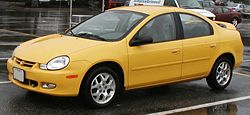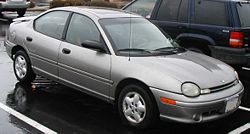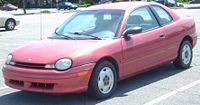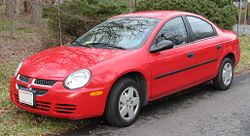Chrysler Neon
 |
|
| Manufacturer | Chrysler Corporation (1995–1998) DaimlerChrysler (1998–2005) |
|---|---|
| Also called | Dodge Neon Plymouth Neon (1995–2001) Dodge SX 2.0 (Canada) |
| Production | 1994–2005 |
| Assembly | Belvidere, Illinois, USA Toluca, Mexico |
| Predecessor | Dodge Colt Dodge Shadow Plymouth Sundance/Duster |
| Successor | Dodge Caliber |
| Class | Compact |
| Layout | FF layout |
| Platform | Chrysler PL platform |
| Related | Dodge SRT-4 |
The Neon was a compact front wheel drive car introduced in January 1994 for the 1995 model year by Chrysler Corporation's Dodge and Plymouth brands. It was branded as a Chrysler model in Mexico, Japan, European and Australian (where it was the first car to be sold as a Chrysler since 1981) export markets, as well as briefly in Canada. It replaced the Dodge Shadow and Plymouth Sundance & Duster models and the Dodge & Plymouth Colt. The Neon was offered in multiple versions and configurations over its production life, which ended on September 23, 2005.
Contents |
1994–1999
 |
|
| Also called | Dodge Neon Plymouth Neon |
|---|---|
| Production | 1995–1999 |
| Body style(s) | 2-door coupe 4-door sedan |
| Engine(s) | 2.0 L A588 I4 2.0 L 420A I4 |
| Transmission(s) | 5-speed NVG T-350 manual 3-speed 31TH automatic |
| Wheelbase | 104.0 in (2642 mm) |
| Length | 171.8 in (4364 mm) |
| Width | 67.5 in (1715 mm) |
| Height | 54.9 in (1394 mm) |
The first generation Neon was introduced in January 1994 and manufactured until 1999. It was available as a four-door sedan or two-door coupe. It was powered by either a 132 hp (98 kW) @ 6000 rpm and 129 ft (39 m)·lbf (175 N•m) @ 5000 rpm SAE 2.0 L SOHC or a 150 hp (112 kW) @ 6500 rpm (R/T DOHC model) and 133 ft·lbf (180 N•m) @ 5600 rpm SAE 2.0 L DOHC four-cylinder engine. The first generation Neon was available with a three-speed automatic transmission or a five-speed manual transmission and was sold as a Dodge and Plymouth in the United States and Canada, and as the Chrysler Neon outside of the United States.
The Neon had more standard power when compared to competitor cars of similar vintage - the Civic DX at 102 hp (76 kW), the Civic EX at 125 hp (93 kW), the Sentra at 115hp, the Escort ZX2 at 130 hp (97 kW), the Corolla at 115 hp (86 kW), etc.
At the Neon's release, then chairman of Chrysler Corporation Robert Lutz said, "There's an old saying in Detroit: 'Good, fast, or cheap. Pick any two.' We refuse to accept that."
First-generation Neons were competitive in SCCA Solo autocross.[1] Available with both the SOHC (sedan) or DOHC (coupe) the ACR was competitive in its class, and featured four-wheel disc brakes, Arvin non-adjustable struts for 1995–1996 models and Koni adjustable dampers for 1997–1999 models, thicker anti-sway bars, fast-ratio steering, heavy-duty front wheel hubs, and a five-speed manual transmission with a numerically higher .81 fifth gear and final drive ratio of 3.94 for quicker acceleration. 1995 through 1997 models featured adjustable camber. The computer-controlled speed limiter was removed from 1995 ACR models, and raised from the standard 190 km/h (118 mph) to 210 km/h (130 mph) for subsequent years. The ACR offers no badging to distinguish it from other Neon models; the only visible differences are a bumper with fog light holes, but no fog lights and a lack of side mouldings. In 1995, the ACR was only offered to SCCA members, but in subsequent years it was available to the general public. The name "ACR" was initially the internal ordering code for the "Competition Package", as it was termed in dealer materials; however, as knowledge of the model spread, the ACR name stuck, and backronyms such as "American Club Racer" were given to it by fans.
The R/T model (Road/Track) debuted in the 1998 model year. Offered only with a 5 speed DOHC configuration, the R/T featured many of the ACR's mechanical upgrades including the numerically higher ratio 3.94 5 speed manual transmission, with the .81 5th gear. The R/T, however, was intended for the street, with more comfort and convenience features standard or available, and specialized parts like the adjustable dampers removed, although the dampers found on R/T models were slightly stiffer, offering an advantage over standard model Neons. R/Ts featured optional stripes over the top of the car, silver "R/T" badging on the front door panels and the right side of the trunk deck lid, and a functional wing. The "Stripe Delete" option was available from the factory, but with no credit to the Neons MSRP. All striped R/Ts (Black,Red,Blue) had silver colored stripes, with the exception of the White R/Ts, which came with dark blue colored stripes.

Neons had unconventional options availability, including the unavailability of power windows in the rear doors. Certain color Neons, including red and black, had bumper covers molded in color rather than painted. These covers while not as glossy as paint, absorbed scuffs and scrapes with less visible damage. The mid-level Highline models were well known for their unique "bubble" hubcap design.
The Australian-market Chrysler Neon came in two models, the SE and the better equipped LX. Later, the LX model was replaced by the LE with the updated model in 1999. In the United States, the lineup started out as Base, Highline, and Sport, with different styles and options in each line, but the lineup titles changed frequently (other trim lines included Expresso, SE, ES, SXT, ACR, and R/T). In Europe, the car was available with a 1.8 L engine. Europe received one limited edition model, the CS, which only came in Platinum paint. It was fitted with the 131 bhp (98 kW) DOHC engine, American R/T specification suspension, rear spoiler and unique alloy wheels.
Trim levels
Plymouth Neon: 1995–1999
- base - 1995–1997
- Highline - 1995–1999
- Sport - 1995–1996
- Expresso - 1996–1999
- EX - 1998–1999
- ACR - 1995–1999
- Style - 1998–1999
Dodge Neon: 1995–1999
- base - 1995–1997
- Highline - 1995–1999
- Sport - 1995–1999
- EX- 1998–1999
- ACR - 1995–1999
- R/T - 1998–1999
- Note: In Canada, both Dodge and Plymouth models were available in an EX package, similar to the Expresso. These models generally featured chrome "EX" badging, along with the "power bulge" hood, among other standard options.
Chrysler Neon (Europe): 1995–1999
- LE - 1995–1999
- LX - 1995–1999
- SLX - 1997
- GLX - 1997–1999
- CS - 1998
2000–2005
 |
|
| Also called | Dodge Neon Dodge SX 2.0 Plymouth Neon |
|---|---|
| Production | 2000–2005 |
| Body style(s) | 4-door sedan |
| Engine(s) | 2.0 L A588 I4 |
| Transmission(s) | 5-speed NVG T-350 manual 3-speed 31TH automatic 4-speed 41TE automatic |
| Wheelbase | 105.0 in (2667 mm) |
| Length | 174.4 in (4430 mm) |
| Width | 67.4 in (1890 mm) |
| Height | 56.0 in (1422 mm) |
| Related | Dodge SRT-4 |
Sales of the second generation model started with model year 2000 and production ended with the 2005 model year. The second generation Neon was only available as a four-door sedan. In some regions, including the United States, the sole engine was the 2.0 L SOHC engine, the power output remaining at 132 HP (98 kW). An optional Magnum configuration with an active intake manifold) that produced 150 HP was available. Both engines had a redline of 6762 RPM.
The second generation was more refined than the first generation car. It was advertised that the second generation Neon had over 1,000 refinements from the original generation. The first generation's frameless windows were replaced with a full-framed door. Other NVH refinements were implemented. The new interior and greater size increased weight. The DOHC engine was no longer available.
In 2001, The R/T trim returned after a one-year hiatus. The R/T consisted on a new 150 horsepower (112 kW) SOHC Magnum 2.0 Liter Engine, 16 inch wheels, spoiler, dual chrome exhaust tips, quicker steering box and stiffer springs. The 2001 R/T had a one-year-only large spoiler — for 2002–, the R/T models wore a rounded spoiler (a smaller version of the SRT-4 wing). The Neon was offered with a Sport package for the 2001 model year only. It consisted of an R/T wing, R/T 16 inch wheels, R/T springs, white instrument cluster and R/T steering box. It was an R/T visually except for the lack of dual exhaust, R/T lower mouldings, fog lamps and R/T exclusive front bumper. The Sport only came equipped with the base model's 132 horsepower (98 kW) engine and was available with an automatic transmission (unlike the manual-only R/T model). 2001 was the last year for the Plymouth Neon, and the Plymouth brand as well, the last Plymouth Neon (which also was the last Plymouth), a silver four-door sedan, rolled off the assembly line on June 28, 2001.
When DaimlerChrysler discontinued the Plymouth brand, the former Dodge and Plymouth Neon were briefly sold under the Chrysler name in Canada from 2000 to 2002, until being replaced by the SX 2.0. In Europe, Australia, Mexico, and Asia, the car had always been sold as a Chrysler, as Dodge and Plymouth passenger cars were not marketed outside the U.S. and Canada. Besides the 2.0 L engine, it used the same Tritec 1.6 L unit found in the MINI prior to 2007. The 1.6 L unit is a variation of the 2.0 L SOHC engine designed by Chrysler and built by Tritec.
Originally, the second generation Neon featured a five-speed manual transmission using the former ACR gear ratios to improve acceleration. However, this hurt gas mileage and made the car noisier on the highway, and eventually the original gear ratios were restored. A four-speed automatic was offered in the Neon for the 2002 model year, with gearing changed the following year.
The Neon's name was changed to SX 2.0 in Canada in 2003. In Australia and Canada, the Chrysler Neon was discontinued in 2002. In 2002, the front clip was changed to match the R/T and ACR front clip. The Neon was facelifted again for 2003 with large "crosseyed" headlights and crosshair grille. The ACR model was discontinued for 2003; the R/T model for 2005. The Chrysler Neon continued to be sold in Europe until 2004.
In Brazil, the Neon was marketed as a luxury mid-size sedan; for Mexico it was a competitor to the Ford Escort, and sold as a Chrysler with either the 1.6- or 2.0-liter engine and European-style taillights (with separate amber indicator lights), except for the R/T model, which was a Dodge, with U.S.-style taillights.
Trim levels
Dodge Neon: 2000–2005
- Highline - 2000–2001
- ES - 2000–2002
- SE - 2001–2005
- ACR - 2001–2002
- R/T - 2001–2004
- base - 2002
- S - 2002
- SST - 2002
- SXT - 2002–2005
- SRT-D - 2005
Plymouth Neon: 2000–2001
- Highline - 2000–2001
- LX - 2000–2001
Chrysler Neon: 2000–2004 (Europe)
- R/T - 2000–2003
- LX - 2000–2004
- SE - 2000–2003
Final year
DaimlerChrysler discontinued the Neon, with the final cars assembled on September 23, 2005 at the Belvidere Assembly plant in Belvidere, Illinois. [2] The Neon was replaced in the spring of 2006 with the 2007 Dodge Caliber, which is based on the shared Chrysler/Mitsubishi Motors GS platform. Like the Neon, the Caliber has an SRT-4 variant. The Belvidere plant underwent retooling for the Caliber, Jeep Compass and Patriot.
In markets like Australia and Brazil the Neon range was reduced to either 2.0 LX or 2.0 SE models.
Correction
DaimlerChrysler stated they were suspending production because of declining sales for 2 years but not discontinuing the Neon. There are in fact 2008 and 2009 models. The Caliber is not it's replacement and is larger and intended to be more up-scale. There has also been reports of a redesign in the works for sometime after 2010 with a possible name change. This is about the same time as the PT Cruiser gets it's redesign. Both of these models share the same platform.
Safety
The first generation Neon earned a "Poor" rating in an offset frontal crash test conducted by the Insurance Institute for Highway Safety. This was the same rating as the Chevrolet Cavalier, Mitsubishi Mirage, and the larger Ford Contour and Hyundai Elantra, but lower than some cars introduced after 1995. The second generation Neon earned a higher "Marginal" rating.
Both generations were rated as "Poor" in the side impact crash test [3] (IIHS Safety ratings go from "Poor", to "Marginal", "Average" and "Good"). Only the Chevrolet Cavalier performed worse in the small car category in 2005, the Neon's final year [4]. Other cars made from 2000 to 2005 which were rated "Poor" when tested without optional side airbags included the Ford Focus, Toyota Corolla, Toyota Prius, Mitsubishi Lancer, and Chevrolet Cobalt. No small car made in this period, tested without side airbags, achieved better than a "Poor."
In 2005, the Institute carried out side impact tests on 14 small car models, simulating an impact with an SUV. Among these, the Neon performed the worst. IIHS stated that the Neon had “...major problems beginning with its structure. This car is a disaster...The structure is poor...If this had been a real driver in a real crash, it’s likely it wouldn’t have been survivable...if safety is a priority, the Neon is a small car to be avoided.” [5]
Second generation headrests were rated as "Poor" [6].
Driver deaths fatality risks statistics -published by the IIHS- rated the Neon among the "Highest rates of driver deaths", with 161 driver deaths per millon registered vehicle deaths. Average for the Neon class (4 door small) was 103 driver deaths per millon registered vehicle deaths [7].
Related
Dodge SRT-4
References
External links
- Chrysler.com - 2001 Plymouth Neon, courtesy of Internet Archive
- Allpar.com - Neon section of Allpar
| Dodge road car timeline, United States market, 1970s–present | ||||||||||||||||||||||||||||||||||||||||
|---|---|---|---|---|---|---|---|---|---|---|---|---|---|---|---|---|---|---|---|---|---|---|---|---|---|---|---|---|---|---|---|---|---|---|---|---|---|---|---|---|
| Type | 1970s | 1980s | 1990s | 2000s | ||||||||||||||||||||||||||||||||||||
| 0 | 1 | 2 | 3 | 4 | 5 | 6 | 7 | 8 | 9 | 0 | 1 | 2 | 3 | 4 | 5 | 6 | 7 | 8 | 9 | 0 | 1 | 2 | 3 | 4 | 5 | 6 | 7 | 8 | 9 | 0 | 1 | 2 | 3 | 4 | 5 | 6 | 7 | 8 | 9 | |
| Subcompact | Omni | |||||||||||||||||||||||||||||||||||||||
| Colt | ||||||||||||||||||||||||||||||||||||||||
| Charger | ||||||||||||||||||||||||||||||||||||||||
| Compact | Colt | 400 | Shadow | Neon | Caliber | |||||||||||||||||||||||||||||||||||
| Dart | Aspen | Aries | ||||||||||||||||||||||||||||||||||||||
| Mid-size | Magnum | Mirada | 600 | Spirit | Stratus | Avenger | ||||||||||||||||||||||||||||||||||
| Coronet | Diplomat | Dynasty | ||||||||||||||||||||||||||||||||||||||
| Full-size | Monaco | St. Regis | Monaco | Intrepid | Magnum | |||||||||||||||||||||||||||||||||||
| Polara | Charger | |||||||||||||||||||||||||||||||||||||||
| Sport compact | Daytona | Avenger | SRT-4 | |||||||||||||||||||||||||||||||||||||
| Sports | Charger | |||||||||||||||||||||||||||||||||||||||
| Challenger | Challenger | Conquest | Stealth | Challenger | ||||||||||||||||||||||||||||||||||||
| SuprB | Viper | |||||||||||||||||||||||||||||||||||||||
| « previous — Plymouth road car timeline, 1970s–2001, North American market | ||||||||||||||||||||||||||||||||
|---|---|---|---|---|---|---|---|---|---|---|---|---|---|---|---|---|---|---|---|---|---|---|---|---|---|---|---|---|---|---|---|---|
| Type | 1970s | 1980s | 1990s | 2000s | ||||||||||||||||||||||||||||
| 0 | 1 | 2 | 3 | 4 | 5 | 6 | 7 | 8 | 9 | 0 | 1 | 2 | 3 | 4 | 5 | 6 | 7 | 8 | 9 | 0 | 1 | 2 | 3 | 4 | 5 | 6 | 7 | 8 | 9 | 0 | 1 | |
| Subcompact | Cricket | Horizon | ||||||||||||||||||||||||||||||
| TC3 | Turismo | |||||||||||||||||||||||||||||||
| Colt | ||||||||||||||||||||||||||||||||
| Compact | Arrow | Sundance | Neon | |||||||||||||||||||||||||||||
| Colt | ||||||||||||||||||||||||||||||||
| Valiant | Volaré | Reliant | ||||||||||||||||||||||||||||||
| Mid-size | Caravelle | Acclaim | Breeze | |||||||||||||||||||||||||||||
| Satellite | Fury | Gran Fury | ||||||||||||||||||||||||||||||
| Full-size | Fury | Gran Fury | Gran Fury | |||||||||||||||||||||||||||||
| Sports | Duster | Sapporo | Laser | |||||||||||||||||||||||||||||
| Barracuda | ||||||||||||||||||||||||||||||||
| Road Runner | Conquest | Prowler | Prowler | |||||||||||||||||||||||||||||
| GTX | ||||||||||||||||||||||||||||||||
| SUV | Trailduster | |||||||||||||||||||||||||||||||
| Pickup | Arrow Truck | Scamp | ||||||||||||||||||||||||||||||
| Minivan | Voyager/Grand Voyager | |||||||||||||||||||||||||||||||
| Van | Voyager | |||||||||||||||||||||||||||||||
|
||||||||||||||||||||||||||||||
|
||||||||||||||||||
|
||||||||||||||||